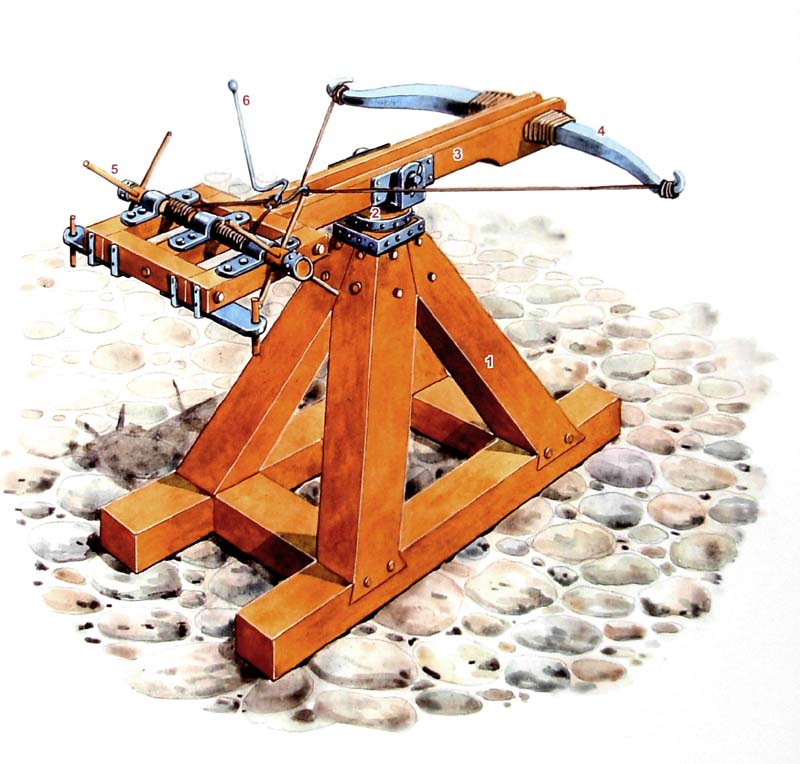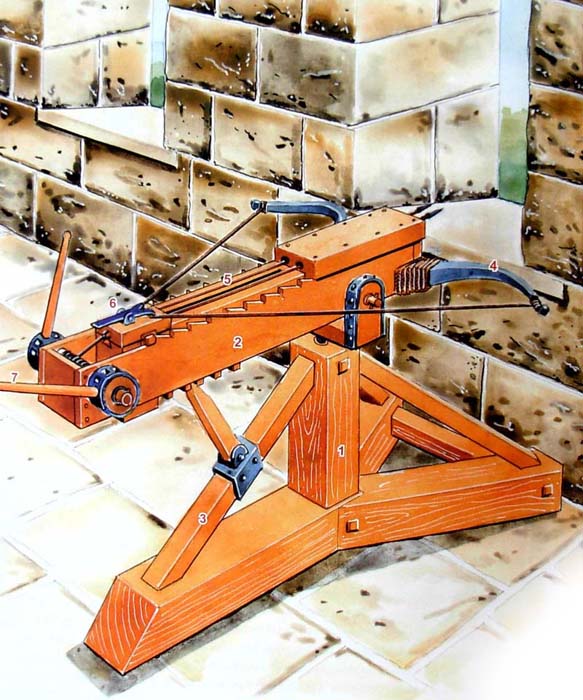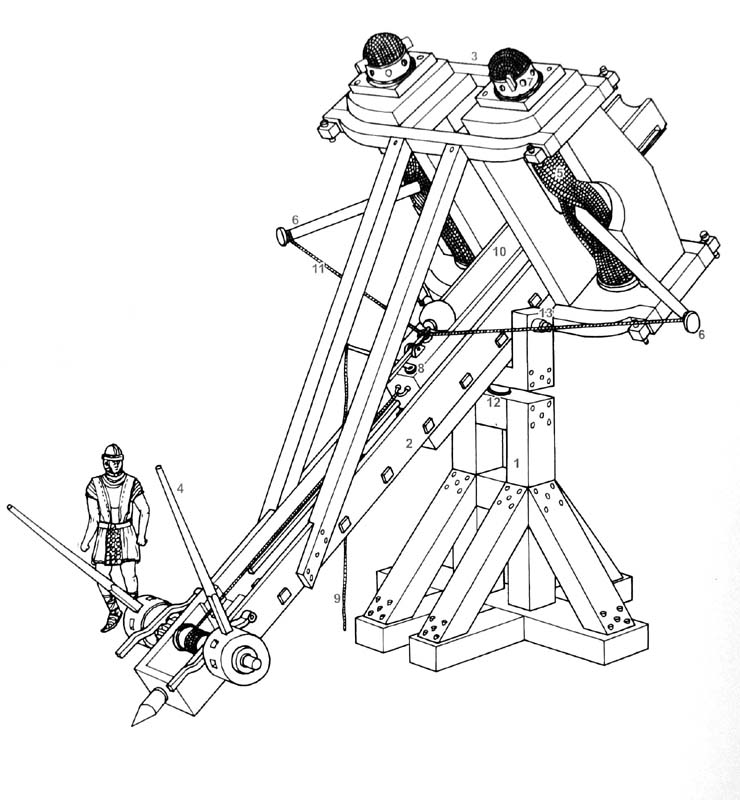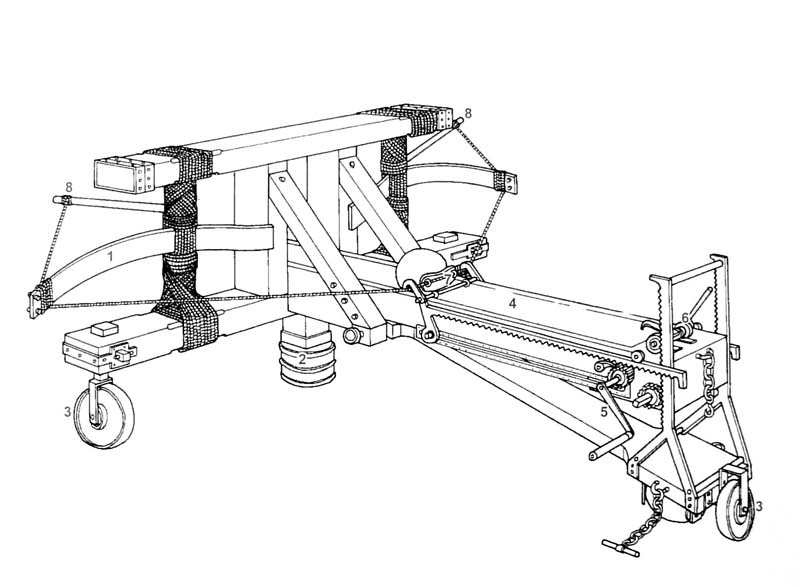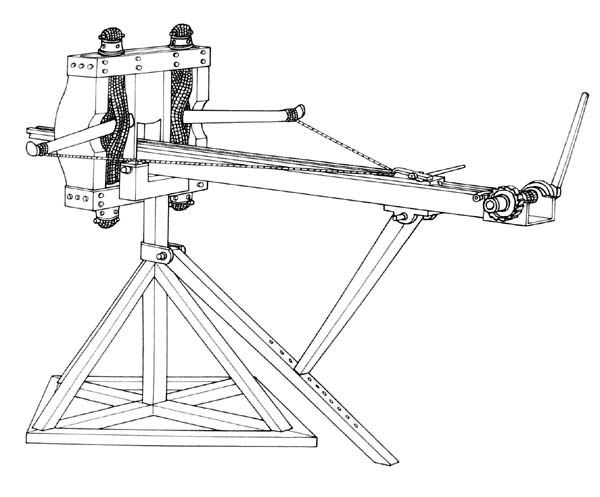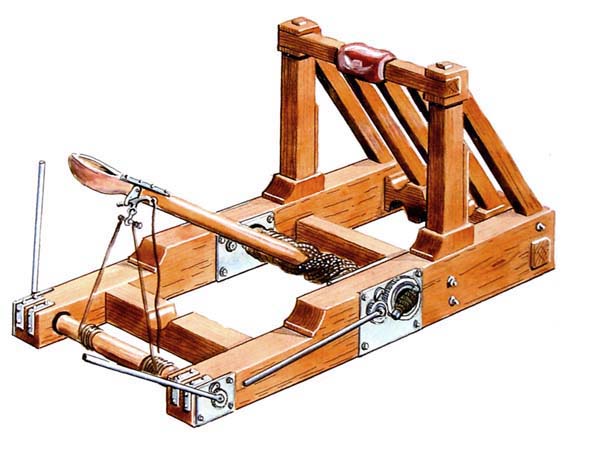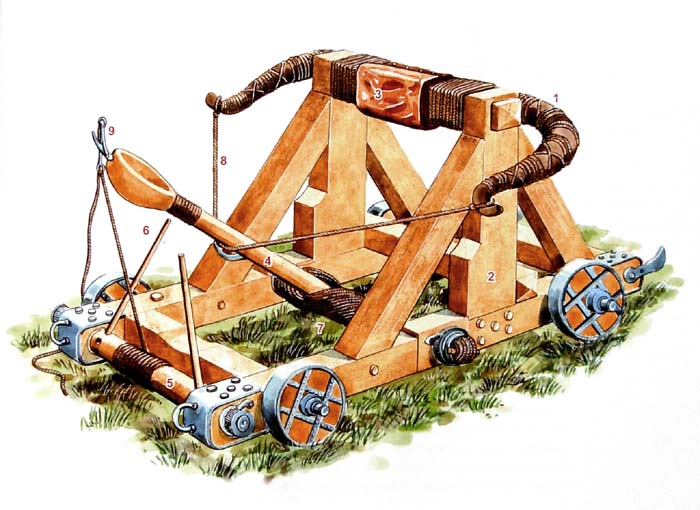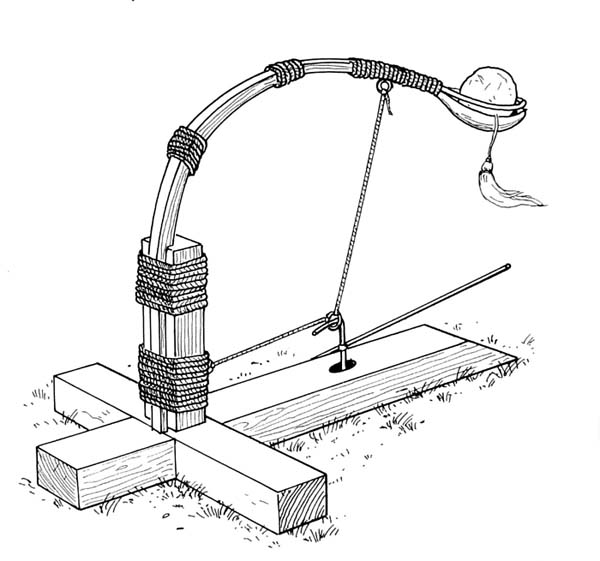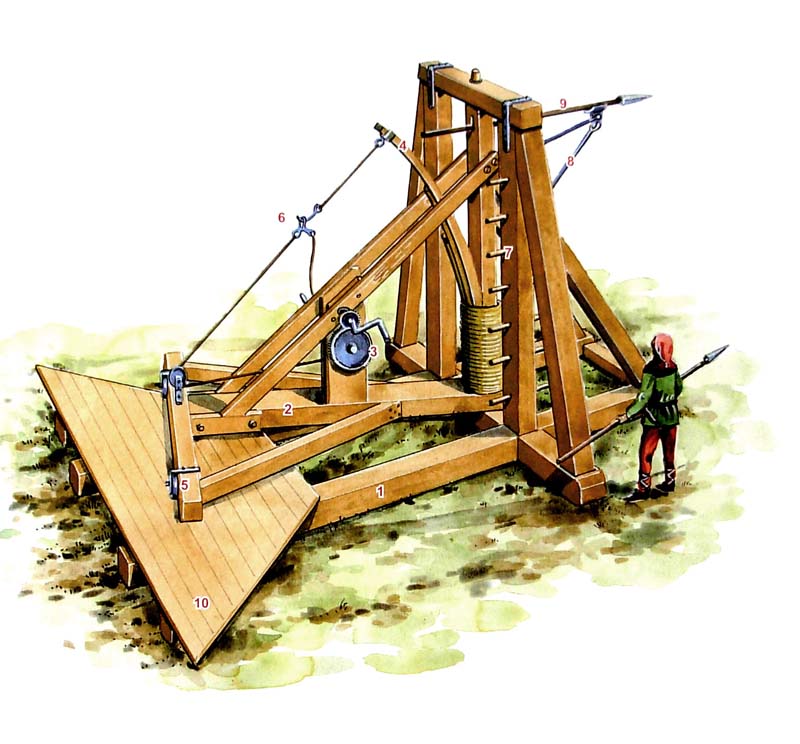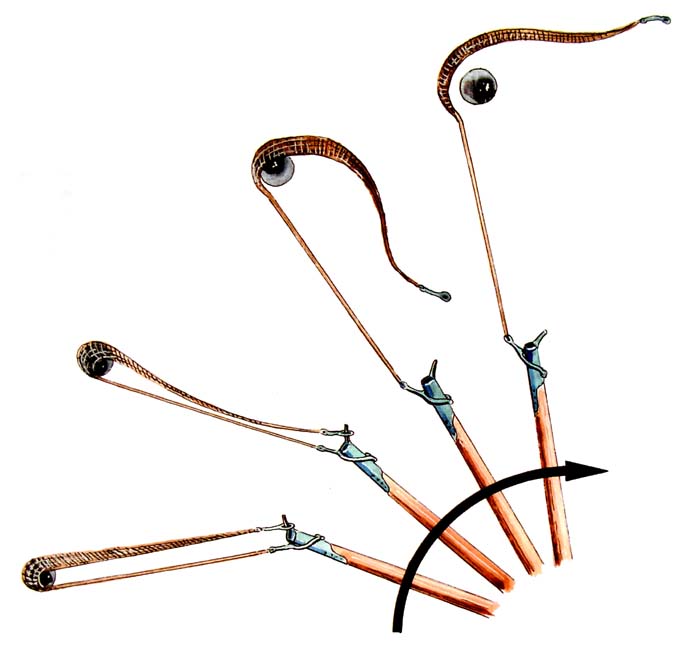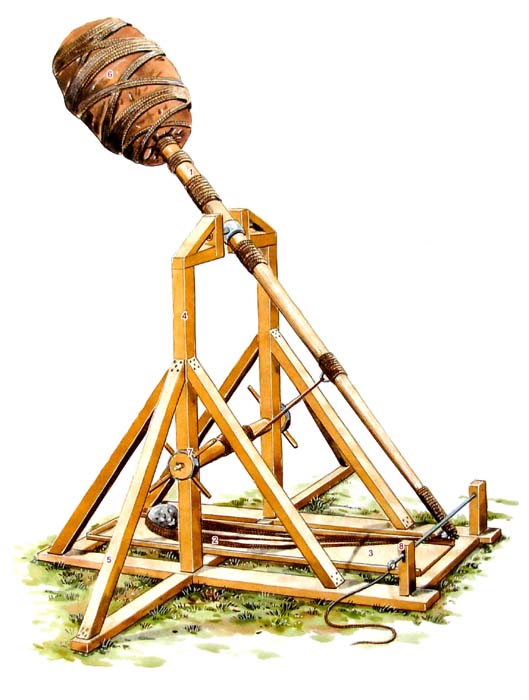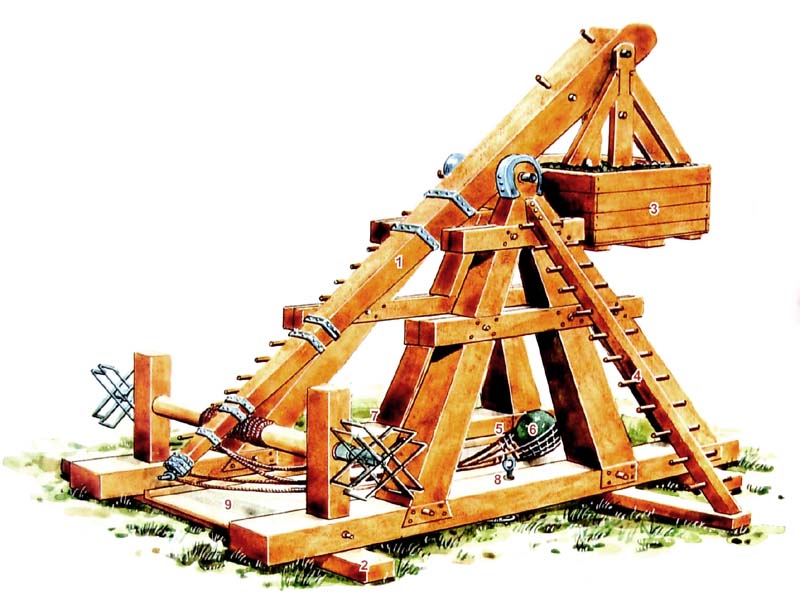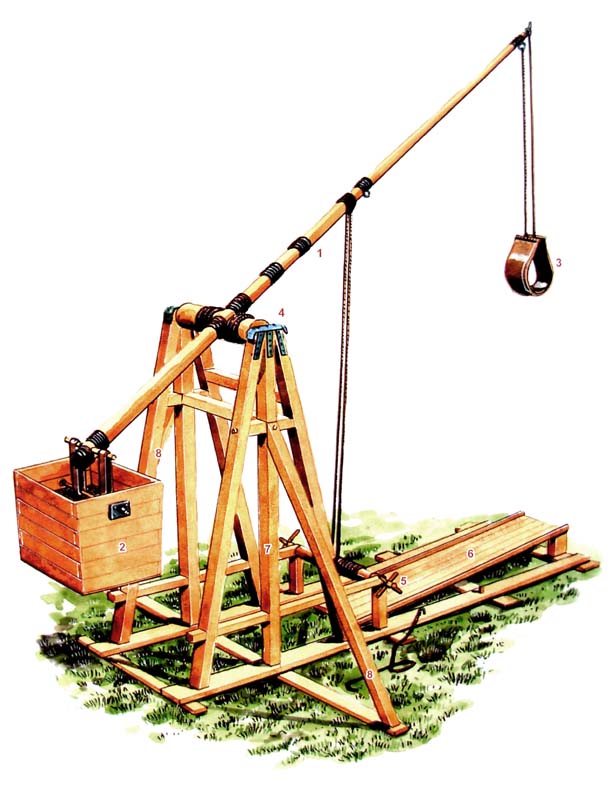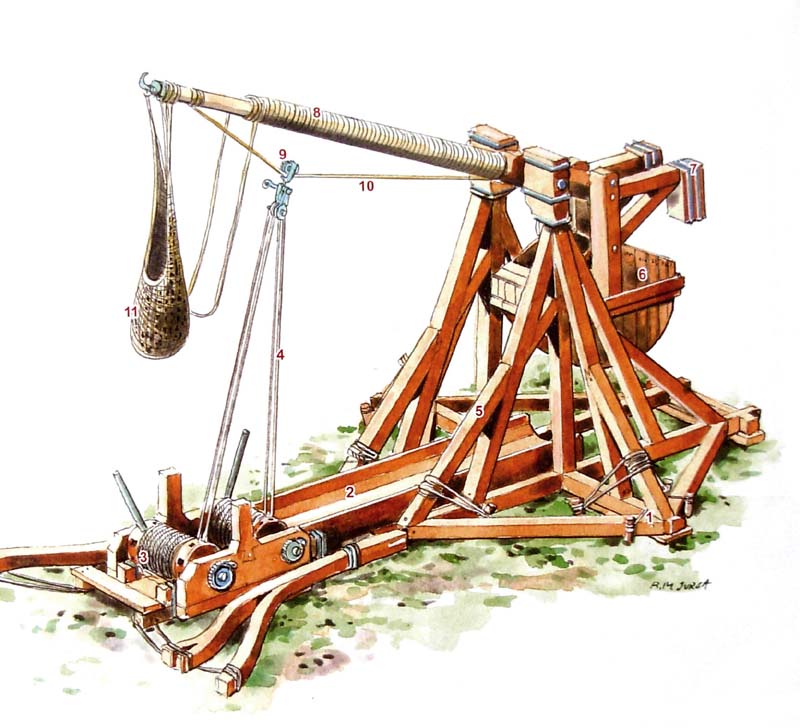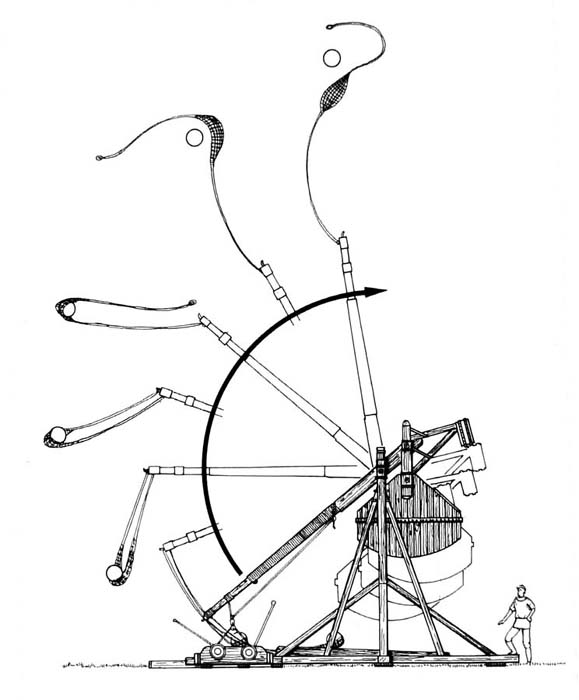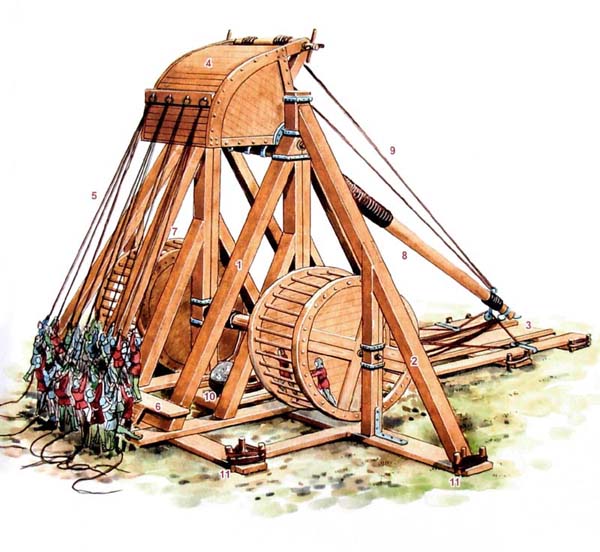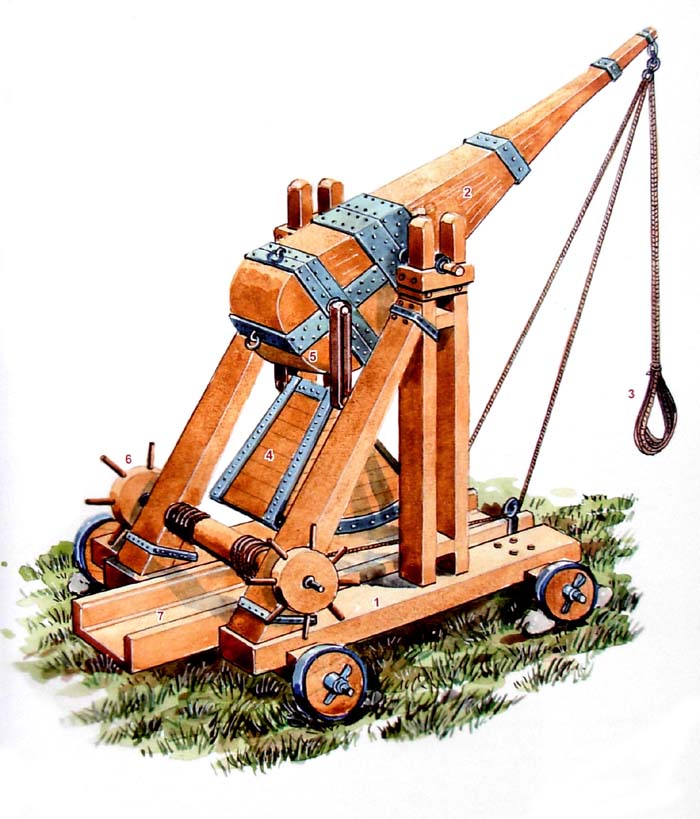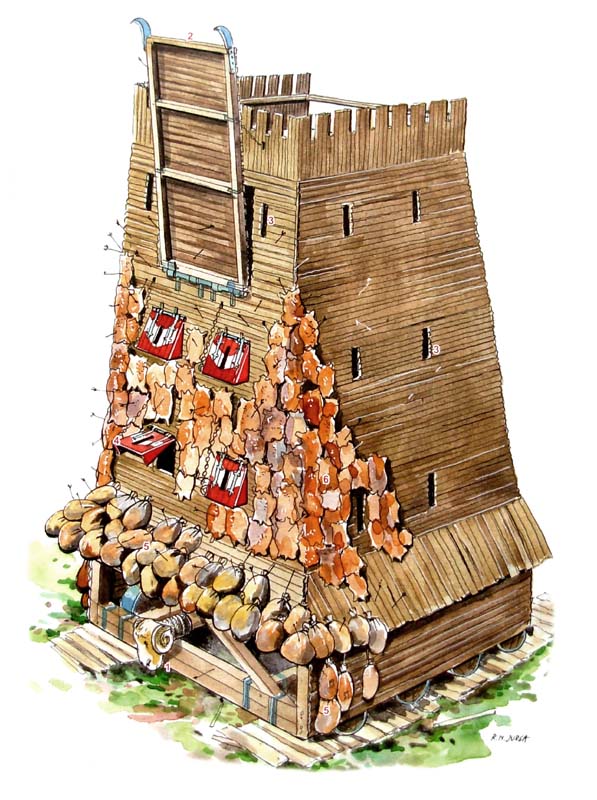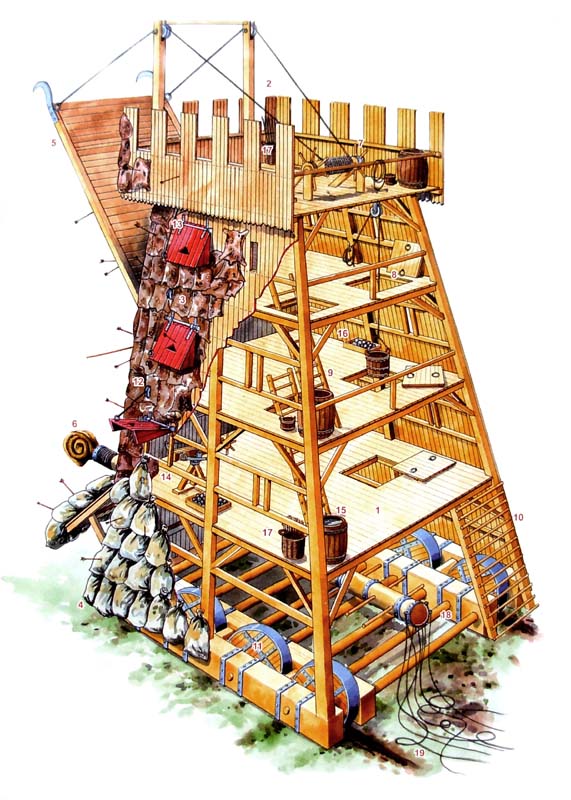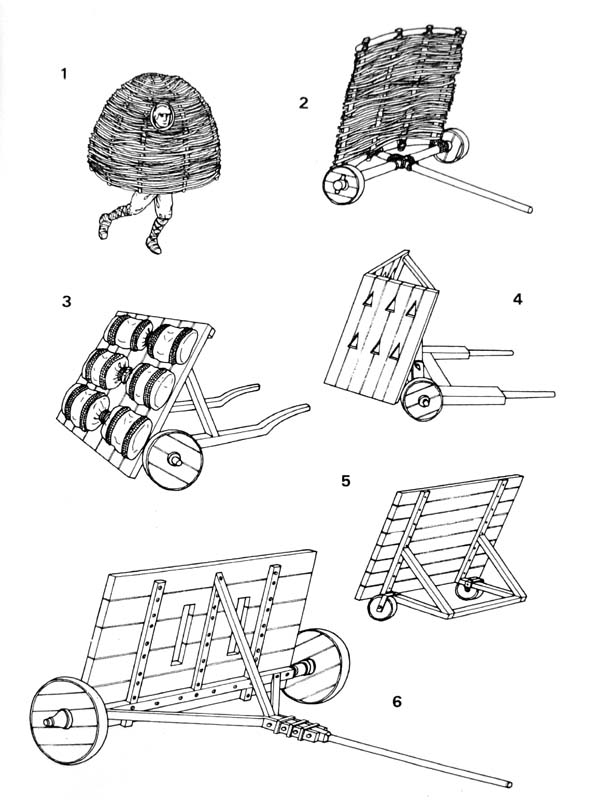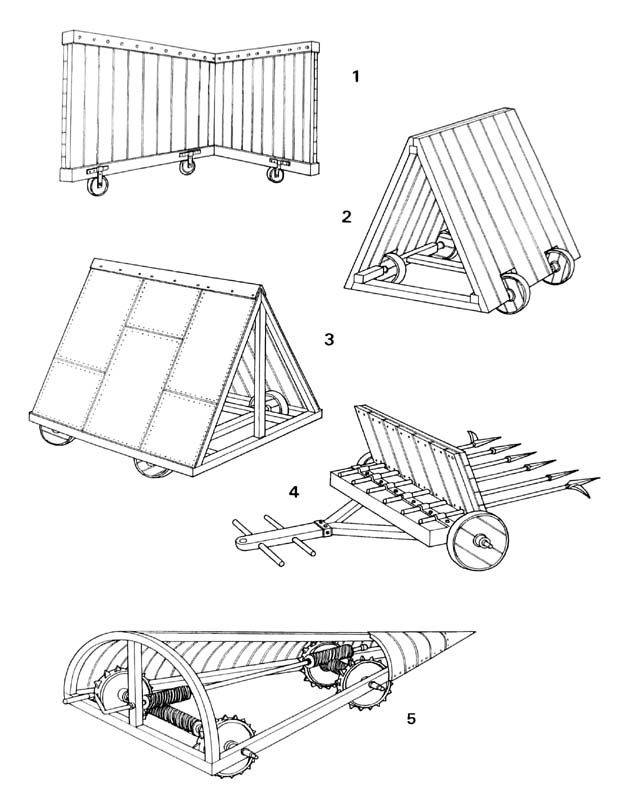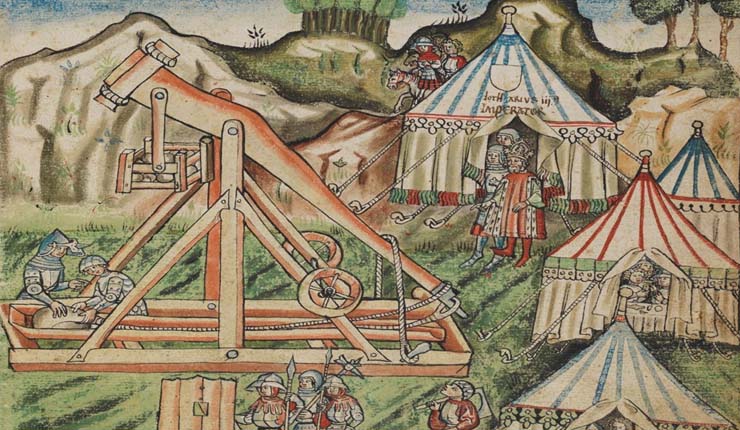
One of the simplest and oldest weapons used during sieges were bows that used the natural elasticity of wood. Along with the development of martial art, their design was improved by using more and more new materials, allowing for increased strength and range. The ancient Greeks used bows made of one flexible piece of wood, but Cretan archers already used composite bows, consisting of a wooden shaft on which the tendon was applied from the convex side and the horn plates from the concave side. The elastic tendon stretched as the string was spread, while the horn plates were compressed, so both materials increased the power of the shot. In ancient times metal bows were also used. It was a weapon operated by one soldier, with metal arms with a chord tensioned by means of a slider pulled in a guide and secured against returning by means of a simple ratchet mechanism. In safety element a trigger was also provided. This bow, called the gastraphetes, was strained not only by the hands, but also by the whole body, leaning the slider on the ground, and the bent butt on the stomach. After the string was tensioned, an arrow was inserted into the guide. Gastraphetes was too heavy to shoot from the hand, so supports were used or it was leaned against the walls. Preparing it for the shot was much longer than a regular bow, but the range and punching strength compensated for this disadvantages.

The propelling weapon with the chord was constantly improved until it began to resemble the commonly known crossbow. In Europe, it appeared on a larger scale only in the tenth century, and its most important modification was the lever used to tighten the string, so that the shooter did not have to put so much force in this action. An appropriately tight chord could throw a bolt even at a distance of 460 meters and pierce the best protected warrior. In the twelfth century, the first units of trained crossbowmen began to be created, but immediately after the first combats, the crossbow was considered a devil’s weapon, unworthy of knighthood and not noble. In 1139, Pope Innocent II even issued a bull prohibiting its use by Christians. However, this ban was never been followed, and the demand for crossbows continued to rise, despite the basic disadvantages of this weapon. Even the most sophisticated crossbowman could fire only two shots per minute and was an extremely easy target during reloading. An additional disadvantage was the high price of the crossbow limiting its availability. Hand crossbows changed their form and construction over the following centuries. In addition to the classic bolt throwing variant, crossbow firing with stone, iron and lead missles were also used. Its variation was the heavy crossbow, used in medieval Europe since the 12th century, belonging to the group of heavy machines throwing missles with a flat track.
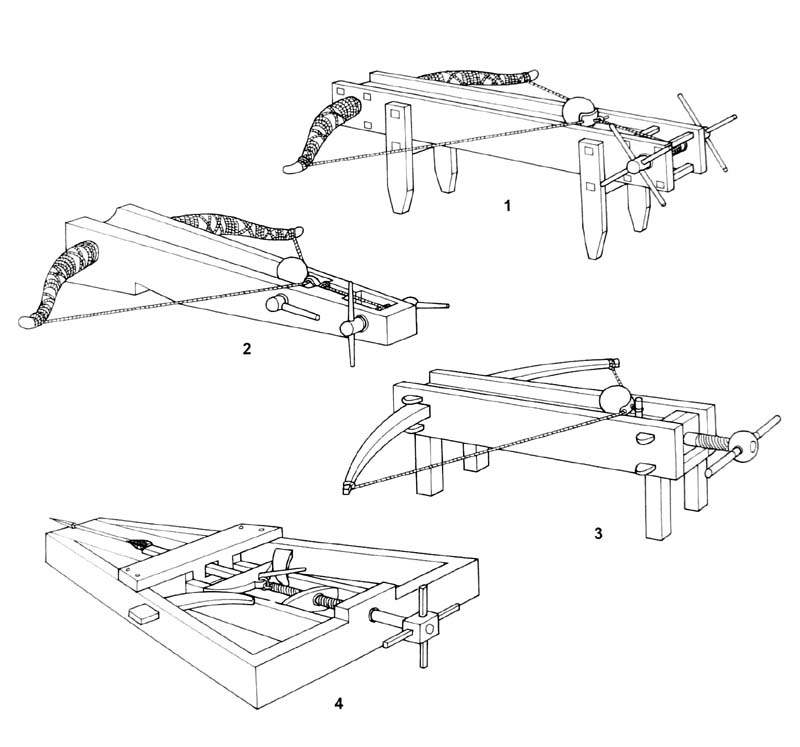
Around 500 BC in Syria, a machine throwing arrows or stone balls steeply through rigid arms was invented, the ends of which were stuck in elastic horsehair ropes. The Phoenicians invented a similar weapon but firing flat-track missiles. Both of these constructions were developed by the ancient Greeks, who called them catapults – catapoltos, as well as Macedonians, where catapults throwing large metal arrowheads weighing up to 78 kilograms and two meters in length and catapults throwing stones weighing about 26 kilograms were especially popular. They were used to destroy the battlement and wall fragments, and to destroy the enemy’s siege machines. A machine throwing missles up a steep track was later called the palintonon by the Greeks, and after the Romans took it over, it received the name of a ballista. The missile-throwing machine on the flat track – eutchytonon, in Rome was called a catapult, ballista or scorpion (scorpio) because, like these spiders, it had arms extended forward. The differences between these devices were insignificant. In each source of strength were two bundles of specially crafted strings, vertically stretched in wooden boxes placed on a movable base, in which two wooden arms of the bow were stuck. Their ends were connected with a chord pulled with a cord winded on a shaft secured with a ratchet mechanism. Correct functioning and accuracy depended on the exact alignment of both bundles of twisted strings, called tonos in Greek. Checking the elasticity was done by pulling each beam and comparing the sounds produced. If they did not sound the same, they were tightened by turning the rings in which they were attached. When they sounded identical, they were blocked by special wedges guaranteeing a stable position. The archer had to have good musical hearing, because the machine was out of tune with any weather changes.
After the Greek catapults were taken over by the Romans, they were divided according to the criterion of their construction. The manualist was a light , hand weapon, throwing arrows and operated by one soldier, often supported by portable stands. Carrobalista was mounted on special two-wheeled carts with a chariot-like appearance. The crew consisted of two soldiers, one of whom was a coachman. The Romans on the battlefield were content with ballistas throwing missiles over short distances, most often they used machines with a range of 50 to 100 meters. They had very different calibers, of 15 minae probably was the most popular, i.e. 6.5 kilograms. Aiming was problematic. The hole in the shield through which the arrow or missle passed was small and little could be seen through it, and in large machines this aiming was out of the question, because the archer had to look beyond the edge of the frame or move away from the ballista to observe the flight and fall of the missle. Accuracy, however, was compensated by the psychological effect caused by ballistas, especially for opponents who did not know such weapons before. The shot and the characteristic sound of the chords being released could even cause panic. Also their firepower was so great that one missle could penetrate several people at once.
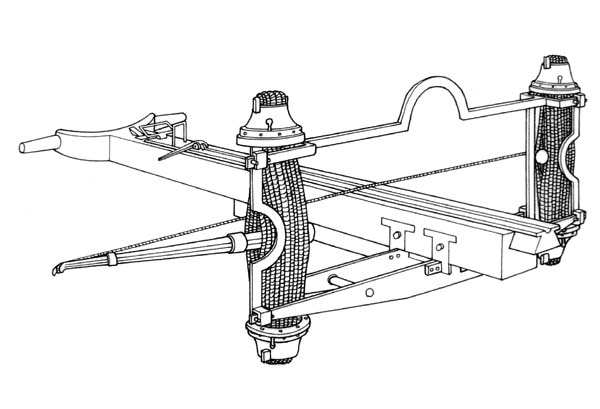
After the fall of the Roman Empire, the ballista was forgotten or significantly simplified. One of the few structures of Roman origin that enjoyed popularity in the Middle Ages was the arcballista (arcuballistae), that is a heavy crossbow set on a two-wheeled carriage, in which the string was tightened with a turnstile. It could throw stone and iron bullets as well as large bolts and wooden missles. Its maximum range was about 900 meters, and the strength of the impact is evidenced by the fact that from 200 meters a half-kilogram bolt pierced a thick beam.
The machine, incorrectly called today a catapult, was an onager or “donkey” in antiquity. This name came from a strong pull and raising the machine in the air after the shot, or like after “kicking a wild donkey”. It was a kind of neurobalistic construction with a rigid arm, one end of which was stuck in a horizontally stretched, strongly twisted bundle of flexible ropes made of animal bristles or veins. They caused that the arm, after unlocking, quickly sought to take an forward oblique position and leaned on the beam that stopped movement. At the other end of the arm, after tensioning it to a horizontal position by means of a turnstile with a ratchet mechanism, a missle was placed in a spoon-shaped or slingshot handle. Onager ejected missles steeply over impressive distances, reaching a ball weighing 50 kilograms to 450 meters. Smaller 30 kilogram missles reached targets even 1000 meters away. The onager’s advantage was the uncomplicated, solid and durable construction, but the trigger mechanism was troublesome, which could injure the archer with his hand. Therefore, a cord or hammer was used more often. Another disadvantage was the rigid base, which required many strong people to move the platform on the new target. These machines were also used in the Middle Ages, but their range was smaller at the time, about 100 meters.
For the construction of the machine called bricoli, natural wood elasticity was used. It was a simple and reliable construction that fired missles on a flat track, widely used until the spread of gunpowder. The primitive version of this device was an ordinary tree with cut branches, on which a flat, appropriately trimmed top was placed a stone. A development of this construction was a machine in which the tree was replaced with a spring beam, bent by means of ropes and a turnstile, mounted in the bottom part to a pole acting as a platform. The movable arm in which javelins or arrows were inserted (single or gathered in bundles) could be raised and lowered, depending on the needs, thanks to the support inserted into the cuts on the pole. In this way, the vertical angle of fire was adjusted, while the horizontal angle remained the same, which, unfortunately, significantly limited the range of fire. This problem was solved in bricoli mounted on a base with a movable pole. With time, the beam was replaced with a metal rod, which increased the range of the shot to 1100 meters.
Trabutium also commonly known as trebuche fired missles steeply with very high accuracy. It was a barobalist machine which used a constant counterweight. It was a kind of beam based on a special structure, one end of which was loaded with a crate or bags filled with stones, sand, clay or lead, and the other was equipped with a slingshot. Rapid dropping of the beam under the influence of the counterweight caused the missle to be thrown. To hit a specific point, the trabutium was rotated to the right or left, if the missle flew too far or did not reach the target, a heavier or lighter bullet was placed in the slingshot, respectively.
Biffa, a barobalist machine that throws missles steeply, was used already in ancient times. The counterweight used in it was stronger than in trabutium, thanks to the movable mounting, allowing the weight to drop vertically. Biffa was characterized by considerable range, but it gave way to machines with a fixed counterweight in terms of accuracy. It is uncertain whether it was a Roman or Byzantine invention, from where it reached Western Europe during the Crusades, where it also appeared under the name blida. Similar machines were also used in Rus region, where they were called porok. According to Arabic sources, it could fire several hundred kilo missles over 200 meters. These machines, called mandżanik, Mongols also used during invasions of Rus.
The development of barobalist machines led to the creation of the tripantium, which was a combination of trabutium and biffa. Because of its size, it is often also called a great trebuchet. This design, with both constant and movable counterweights, fired more accurately than a biffa and further than a trabutium. Probably with the help of such machines a breach in the walls of Jerusalem was made during the first Crusade in 1099. The peak achievement was the tripantium built in the 13th-century Picardy by Wilard de Honnecourt. Its movable counterweight contained 26 tons of soil, and the constant counterweight served as a shock absorber when firing. In addition, the whole structure was stabilized with wooden poles driven deep into the ground.
The construction of siege towers has not changed significantly throughout history. Mostly they were buildings in the shape of a truncated pyramid with a wooden grate structure, covered with boards in a vertical arrangement. The whole was additionally covered with non-fire materials in the form of properly crafted animal leathers, sheets or leather bags filled with sand. If possible, the front wall was tried to be made in a vertical form, which would facilitate access to the besieged walls. Some towers could have lowered platforms manually or with the help of ropes and turnstiles, with the help of which the invaders crossed the walls. Attempts were made to build towers higher than the crown of the walls, which made it easier to shoot and knock down defenders. For example, the siege tower described by Vitruvius was 34 meters high, the side was almost 10 meters long, and it had ten battle stories. Even greater was 69 meters high, at the base of the square with a side length of 13 meters. Each floor was equipped with arrowslits and a fighting porch running around, and at the base the wheels enabling the movement of this massive structure. In the siege towers, in the lower part there could be a ram, the upper floors served as positions for various firing machines and archers.
The use of siege towers could have caused a lot of trouble for the attackers. The approach to the fortifications was lined with obstacles in the form of embankments and ditches, and often the very slope of the area could be a problem. However, when this art was successful, most often after the construction of a special ramp or leveling the terrain, they played an extremely important role in battle. On the one hand, they protected the attacers against missles, on the other, they allowed a direct attack on the walls, shelling the fortress interior, crumbling its walls, observing the battlefield or mining under their cover.
The construction of siege towers required time and the right amount of material, so it was a costly undertaking. To make the assault in the shortest possible time and in several places simultaneously, much simpler and cheaper constructions were used. It were landing baskets that could simultaneously and periodically deliver several soldiers to the walls of the captured fortress. Wooden cranes with baskets called toleno, used in antiquity, were used until the 17th century. Mostly they consisted of a base, often equipped with wheels, in the center of which a high permanent or rotary structure was mounted, supporting a movable, crane-operated beam. The strength of human muscles or a turnstile installed on the base was used to raise and slide the basket or barrel over the crown of the walls. Prior to the attack, the attackers took their place in the basket and left it only after joining the walls.
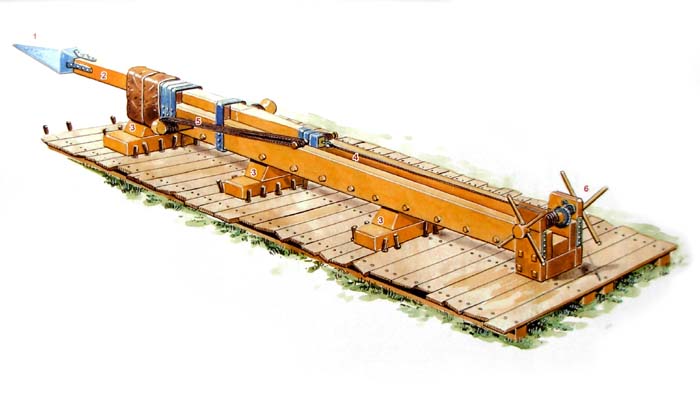
One of the oldest siege devices was certainly the battering ram. Due to its simple design, reliability in combat and the ability to quickly build, it was almost always used when capturing fortified places. A craftsman from Tire named Pefrasmenos placed a second beam perpendicular to the lying one, thus creating the first ram on the movable base. Thanks to this, it was possible to increase the weight of the beam, and at the same time increase its efficiency and reduce the number of crew. Geras from Chalkedon, on the other hand, was the first to invent a structure on wheels covered with leather, inside of which a ram was hung on the ropes. Like most other siege devices, rams were usually built on the battlefield before the assault. However, there were cases of traveling rams with the army, because not always the right building material was nearby. Mostly the beam length ranged from 8 to 30 meters, and its weight reached up to 16 tons. Each time it was adapted to the thickness of the walls and gates under attack. The end of the beam which was most susceptible to destruction during the attack, was forged in bronze or iron and often took the shape of a ram or turtle’s head. Battering rams were often installed in sheds called muscles or in siege towers.
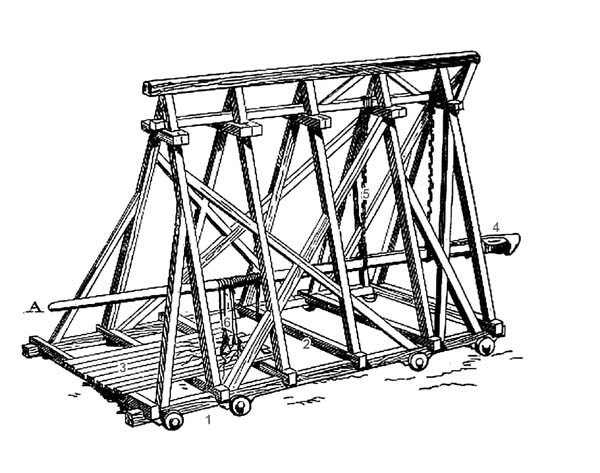
Already in ancient times, shields were widely used, which not only protected against arrows and stones, but also allowed to perform preparatory work for the assault. The first movable curtain was probably an ordinary wicker basket with a small opening to observe the surroundings. With time, large covers – mantlets, began to be used, in the form of walls mounted on carts or having their own wheels and a drawbar, so that moving these constructions was not a problem. The covers were usually made of wicker, boards or brushwood and covered with specially impregnated animal leathers, resistant to fire. Some mantlets also had a small roof and side walls, or resembled small sheds. If defenders stood in front of the fortress walls, spears, scythes, spades and other stabbing weapons were additionally mounted on the front wall. In the Roman army these constructions were called winea and supplied with rams. Under their cover, the curtains were approached to crush the walls, break down the gates or carry out the miners’ work, consisting mainly in digging and undermining the foundations of the buildings.
The sieges could not do without a basic siege structure, that is an ordinary ladder. Easy to make and light to use, however, had many disadvantages: it could not be used with very high walls, because of their length it was difficult to transport it and only one by one attackers could climb on them, while the ladder was easly pushed away by the besieged. Also you had to be careful not to break down under the weight of the attackers. There were attempts to solve transport problems using rope or segment ladders, stacked one on top of the other, but they were not resistant to destruction. To make it harder to push the ladder away from the wall, its ends were equipped with strong iron hooks, which were hooked to the edges of the wall.
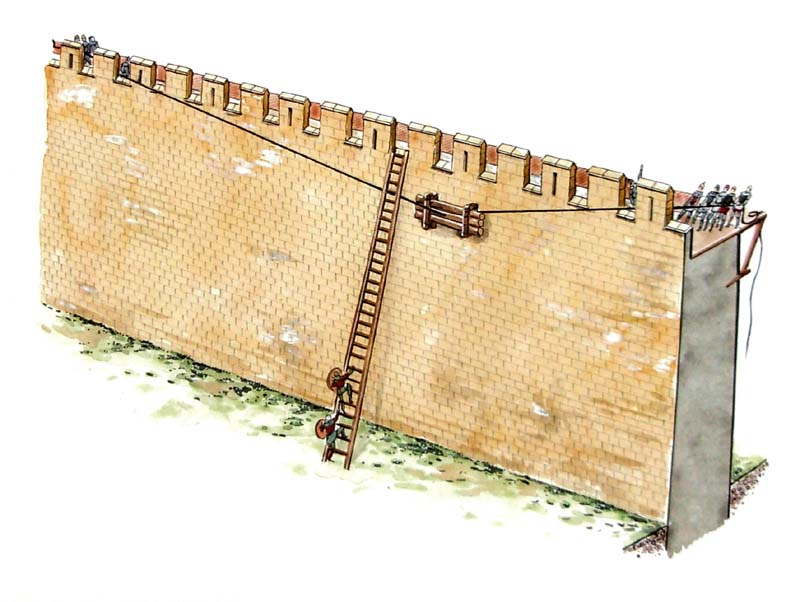
The post was based on excerpts from the book of Roberta M.Jurga, Machiny wojenne. Zapomniana technika wojskowa, Poznań 2011. Also used with the permission of the author a series of graphics made by him.

